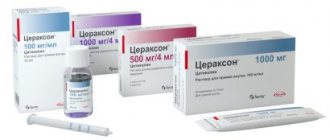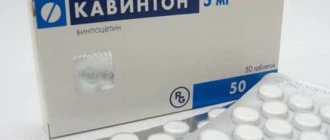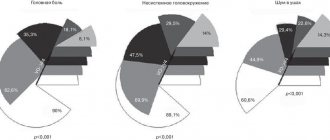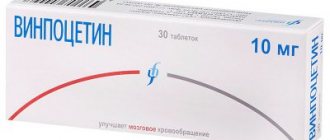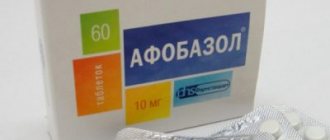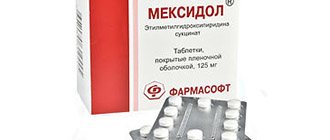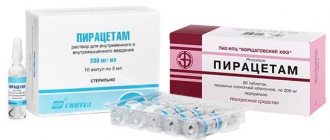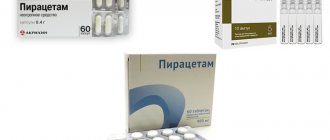pharmachologic effect
Antihypoxic, antiaggregation, neuroprotective, vasodilator, improves cerebral circulation.
Pharmacokinetics
Suction
After oral administration, it is quickly absorbed. Cmax in blood plasma is achieved 1 hour after administration. Absorption occurs mainly in the proximal gastrointestinal tract. When passing through the intestinal wall it is not metabolized. Cmax in tissues is observed 2-4 hours after oral administration. Bioavailability is 7%.
Distribution
With repeated oral doses of 5 mg and 10 mg, the kinetics are linear.
Binds to plasma proteins by 66%. Penetrates through the placental barrier.
Metabolism and excretion
Clearance of 66.7 l/h exceeds the plasma volume of the liver (50 l/h), indicating extrahepatic metabolism.
T1/2 is 4.83±1.29h. Excreted in urine and feces in a ratio of 3:2.
Pharmacodynamics
Improves brain metabolism by increasing the consumption of glucose and oxygen by brain tissue. Increases the resistance of neurons to hypoxia, enhancing the transport of glucose to the brain through the BBB; transfers the process of glucose breakdown to the more energy-efficient aerobic pathway; selectively blocks Ca2+-dependent phosphodiesterase; increases levels of AMP and cGMP in the brain. Increases the concentration of ATP and the ATP/AMP ratio in brain tissue; enhances the exchange of norepinephrine and serotonin in the brain; stimulates the ascending branch of the noradrenergic system and has an antioxidant effect.
Reduces platelet aggregation and increased blood viscosity; increases the deforming ability of red blood cells and blocks the utilization of adenosine by red blood cells; helps increase oxygen delivery by red blood cells. Strengthens the neuroprotective effect of adenosine.
Increases cerebral blood flow; reduces the resistance of cerebral vessels without significant changes in systemic circulation parameters (BP, minute volume, heart rate, peripheral vascular resistance). Not only does it not have a “stealing” effect, but it also increases blood supply, primarily in ischemic areas of the brain with low perfusion.
The drug Cavinton Forte will improve cerebral circulation
Cavinton forte or Cavinton are drugs used to eliminate cerebrovascular accidents.
Medicines have an antiaggregation effect on the body, promote vasodilation, improve and normalize blood flow in the brain.
The drug is available in the form of tablets and concentrate for the preparation of infusion solution.
Cavinton contains the active component vinpocetine. In addition to the active substance, the tablets contain additional components that play a supporting role:
- talc;
- silicon dioxide;
- magnesium stearate;
- lactose monohydrate;
- corn starch.
In the composition of the concentrate for the preparation of infusion solution, the auxiliary compounds are:
- tartaric acid;
- sodium disulfite;
- water for injection;
- benzyl alcohol;
- ascorbic acid;
- sorbitol.
The tablet form is packaged in blisters; the tablets are white in color. The concentrate for the preparation of infusion solution is a clear liquid.
The main active ingredient belongs to the group of cerebrovasodilating agents. The use of the drug improves metabolism in tissue cells and blood supply to the brain. Cavinton is able to influence the rheological properties of blood. Under the influence of vinpocetine, the activity of transmembrane calcium and sodium channels, AMPA and NMDA receptors is inhibited.
Cavinton is able to influence the rheological properties of blood.
Under the influence of vinpocetine, the absorption and metabolism of oxygen and glucose by brain tissue cells improves, and the processes of serotonin and norepinephrine synthesis are activated. The drug is able to have antioxidant and stimulating effects on the noradrenergic system of the body.
Indications for use of the drug are extensive:
- in neurology - ischemia, vascular dementia, stroke, cerebral vascular atherosclerosis, vertebrobasilar insufficiency, post-stroke condition, hypertensive, post-traumatic encephalopathy and other types of cerebral circulatory failure, memory impairment, headaches and motor activity disorders;
- in ophthalmology - spasm of retinal blood vessels, atherosclerosis, degenerative diseases, development of secondary glaucoma, thrombosis, embolism;
- in otorhinolaryngology - age-related hearing loss, hearing impairment of toxic and vascular origin, cochleovestibular neuritis, Meniere's disease, dizziness, the appearance of tinnitus, vasovegetative manifestations in the menopause.
Indications for use of Cavinton forte
Neurology: to reduce the severity of neurological and mental symptoms in various forms of cerebral circulatory failure (including conditions after an ischemic stroke, the recovery stage of hemorrhagic stroke, the consequences of a stroke, transient ischemic attack, vascular dementia, vertebrobasilar insufficiency, cerebral atherosclerosis , post-traumatic and hypertensive encephalopathy).
Ophthalmology: chronic vascular diseases of the choroid and retina.
Otorhinolaryngology: for the treatment of perceptual hearing loss, Meniere's disease, idiopathic tinnitus.
To avoid complications, use strictly as prescribed by your doctor.
Pharmacology of the drug
Increases blood supply to areas subject to ischemia, relaxes the smooth tissue of brain vessels. Affects metabolism. Slows down the processes of phosphodiesterase and adenylate cyclase, increasing the levels of cyclicity of adenosine monophosphate and ATP (adenosine triphosphate). As a result, the blood vessels of the brain dilate, oxygen transportation improves, and the body’s resistance to hypoxia increases; the process of glucose absorption is activated, the process of metabolism and seratonin in the brain increases. Platelet dismerism decreases.
Use during pregnancy and children
Cavinton® Forte is contraindicated for use during pregnancy, because Vinpocetine penetrates the placental barrier. Moreover, its concentration in the placenta and in the blood of the fetus is lower than in the blood of a pregnant woman. When taken in high doses, placental bleeding and spontaneous abortion may develop, probably as a result of increased placental blood supply.
Within 1 hour, 0.25% of the administered dose of the drug is excreted in breast milk. If it is necessary to use the drug during lactation, breastfeeding should be stopped.
What is the difference between Cavinton and Cavinton Forte
The first difference between the drugs is the amount of the active ingredient in the tablets. Cavinton contains 5 mg of vinpocetine. In Cavinton Forte, the main substance is twice as much - 10 mg. The content of vinpocetine affects the dosage and frequency of use.
Cavinton contains 5 mg of vinpocetine.
Cavinton is sold in 2 types - whitish tablets and a solution for intravenous infusion.
The concentrate for infusion contains excipients in the form of:
- vinpocetine - 5 mg;
- tartaric acid;
- sodium disulfite;
- injection water;
- benzyl alcohol;
- ascorbic acid;
- sorbitol.
Cavinton Forte is available only in tablet form.
Intravenous administration of the solution is indicated for those people who have problems with the digestive tract. This allows you to avoid the development of side effects and provide a therapeutic effect faster.
There will be a difference in the application pattern. Since Cavinton Forte contains 10 mg of active ingredient, it is recommended to drink the medication 1-2 times a day. The frequency of taking Cavinton tablets is 3 to 4 times a day. At the end of the course, the dosage is reduced gradually over 3-5 days.
Cavinton in solution is administered intravenously using a dropper. The daily amount of medication is 20 mg. The rate of administration is 80 drops per minute. An open bottle is used within 3 hours.
Price
Cost of Cavinton Forte tablets 30 pcs. is 2550-300 rubles, 90 pcs. — 620 rub.
The price of Cavinton is lower than that of its analogue. Dosage 5 mg 50 pcs. costs 229 rubles. Ampoules 10 pcs. sold for 246 rubles.
We recommend reading: Curantil 75: instructions for use
Side effects
Side effects associated with the use of the drug were rarely detected.
From the cardiovascular system: ECG changes (ST depression, prolongation of the QT interval); tachycardia, extrasystole (however, the presence of a causal relationship has not been proven, since in the natural population these symptoms are observed with the same frequency); lability of blood pressure, feeling of hot flashes.
From the central nervous system: sleep disturbances (insomnia, increased drowsiness), dizziness, headache, general weakness (these symptoms may be manifestations of the underlying disease).
From the digestive system: dry mouth, nausea, heartburn.
Other: allergic skin reactions, increased sweating.
Cavinton Forte - official instructions for use, analogues
Each drug, regardless of its spectrum of action, should be used only for its intended purpose. Therefore, it is important to carefully study the instructions for use of Cavinton. It significantly expands the possibility of effective therapeutic treatment of pathologies of vascular diseases of the brain. Therefore, it is worth knowing its features, disadvantages and dosage regimen.
"Cavinton" refers to drugs that have an effect on the cardiovascular system and significantly improve cerebral circulation, due to which it is widely used in neurology, ophthalmology and otolaryngology.
Drug interactions
No interaction is observed when used simultaneously with beta-blockers (chloranolol, pindolol), clopamide, glibenclamide, digoxin, acenocoumarol and hydrochlorothiazide, imipramine.
The simultaneous use of Cavinton® Forte and methyldopa sometimes caused a slight increase in the hypotensive effect, therefore, when using this combination, regular blood pressure monitoring is required.
Despite the lack of data confirming the possibility of interaction, it is recommended to exercise caution when prescribing Cavinton Forte simultaneously with centrally acting drugs, antiarrhythmics and anticoagulants.
Cavinton forte dosage
The duration of treatment and dose are determined by the doctor.
Inside, after eating.
Typically the daily dose is 15-30 mg (5-10 mg 3 times a day). The initial daily dose is 15 mg. The maximum daily dose is 30 mg.
The therapeutic effect develops approximately a week from the start of taking the drug. It takes 3 months to achieve the full therapeutic effect.
For diseases of the kidneys and liver, no adjustment of the dosage regimen is required; the absence of accumulation allows for long courses of treatment.
What are the differences and similarities between Cavinton and Cavinton forte?
Cavinton has more release forms compared to Cavinton Forte. Both drugs contain the same active ingredient.
Both drugs have similar indications for use, contraindications and side effects. Medicines must be taken after meals with plenty of water.
The selection of drug dosage depends on the type of pathology and individual characteristics of the body.
Cavinton forte contains 2 times more active component than Cavinton. This indicator affects the frequency of dosing of the drug.
Due to the higher content of the active component, the dosage regimen for the drug has been changed. It is recommended to take Cavinton forte 1-2 times a day, and Cavinton 3-4 times a day.
